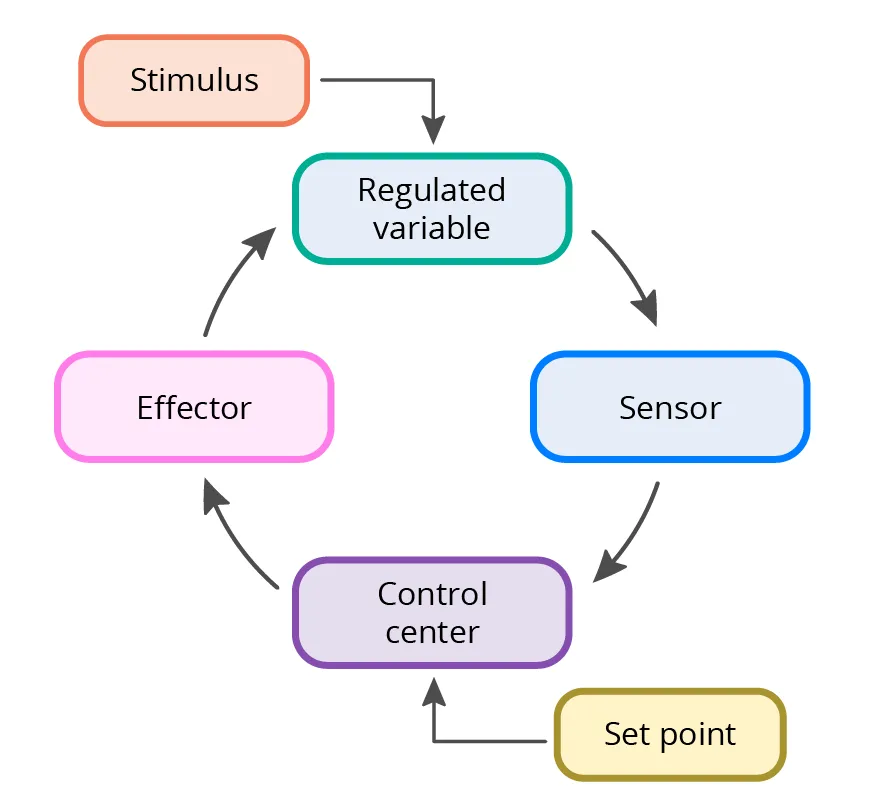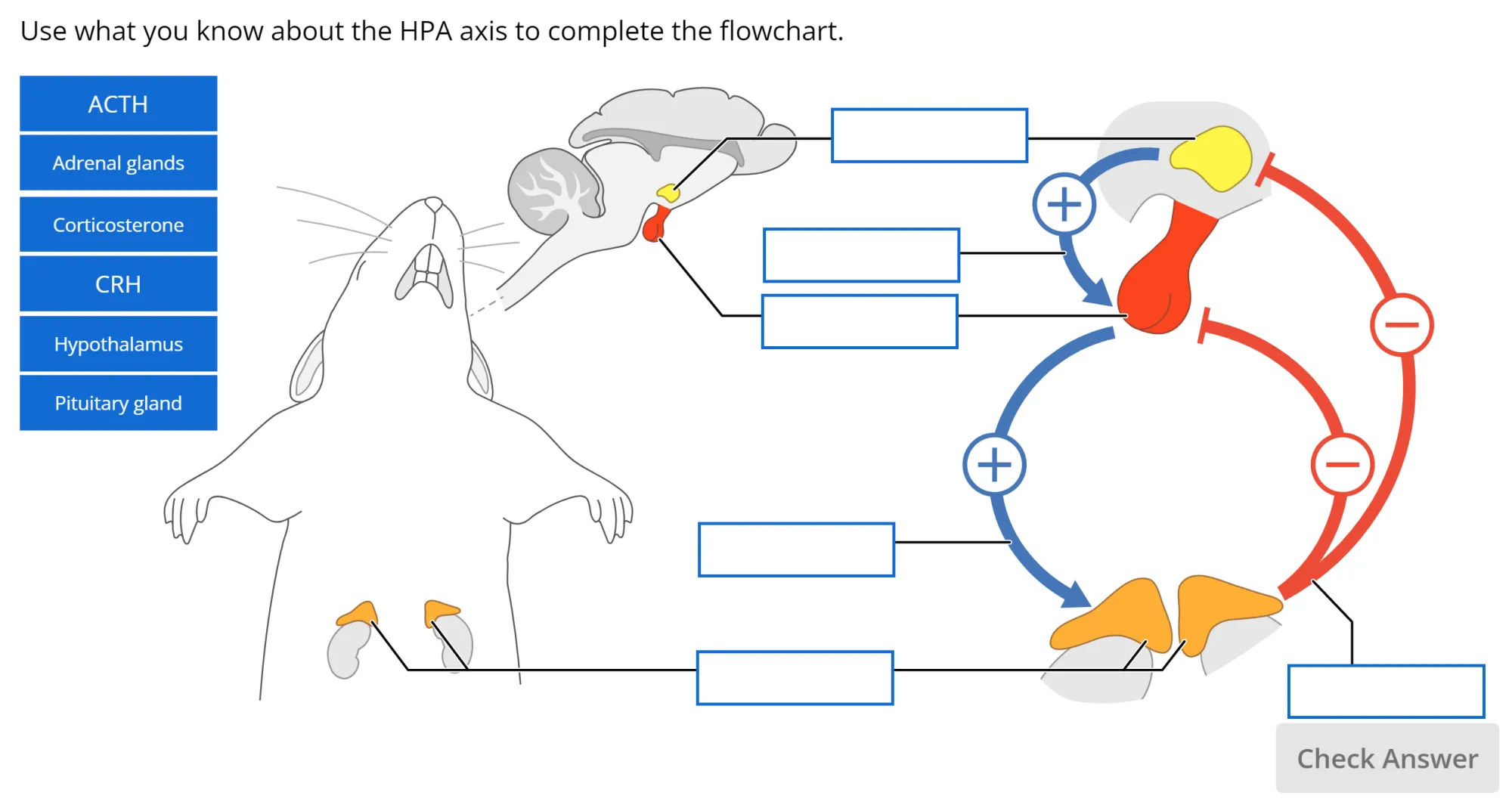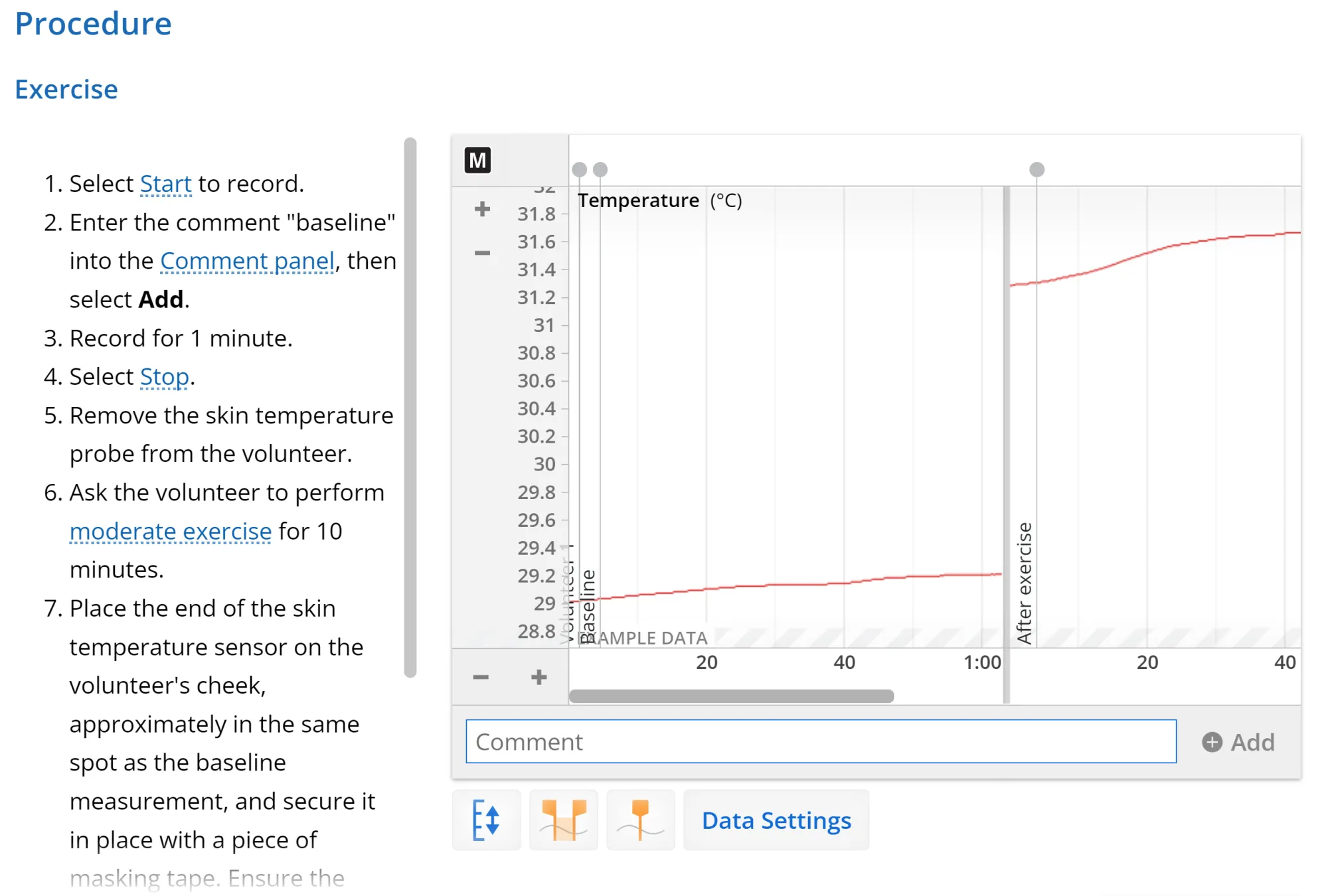Homeostasis is a crucial concept in the study of physiology. Here are 7 ways to teach homeostasis in your physiology courses.
What is homeostasis?
A key concept of physiology, homeostasis has been defined as “the maintenance of a relatively stable internal environment” (Chirillo, 2021) in the face of environmental change.
First proposed by Claude Bernard, who noted the importance of a stable internal environment (extracellular fluid) to survival, the term homeostasis was later coined by Walter Cannon (as reviewed by Modell et al., 2015).

Although students sometimes mistakenly think that homeostasis means there is no change (everything remains the ‘same’), homeostatic processes are in fact dynamic and actively maintained (Chirillo, 2021).
How does homeostasis work?
Regulated variables (for a homeostasis example, body temperature or mean arterial blood pressure) have an ideal set point, and this value can vary dynamically within a certain range (Chirillo, 2021).
The variable (e.g. body temperature) is monitored by specialized sensors in the body which can set in motion homeostatic mechanisms to return the value to its set point if it exceeds the acceptable range (Chirillo, 2021).
Negative feedback is a process that reflexively keeps systems tightly-regulated near their set points. In the face of external change (for example, the body temperature increases), a negative feedback loop is able to detect this change and set in motion actions that will bring the body temperature back down toward its set point.
For this process to occur, the following components are required:
- A regulated variable to be measured.
- A set point for reference.
- A sensor or receptor to detect deviations from the set point.
- A control center or integrator to compare the value to the set point and send signals to the effector(s).
- An effector(s) to make an appropriate change that will move the value of the regulated variable back toward the set point.
Negative feedback loops are most commonly covered by introductory physiology courses compared to other homeostatic mechanisms (as reviewed by Chirillo, 2021), and so we focus on them here.
Why is homeostasis important when teaching physiology?
Homeostasis is essential to survival and is a common mechanism across body systems. If uncontrolled, regulated variables like body temperature or blood glucose levels can lead to sickness or even death.
As such, homeostasis is important in the education of aspiring scientists and physicians, and has been identified as one of 14 Core Concepts of Physiology by the American Physiology Society. Homeostasis is also a prominent theme in the Human Anatomy and Physiology Society’s Physiology Learning Outcomes, released in 2023.
Unfortunately, students struggle to understand homeostasis and may incorrectly think about it “as a static internal environment” (Chirillo, 2021). 79% of third-year students entering an Animal Physiology course were unable to accurately define homeostasis (Chirillo, 2021), while 200-level physiology students have been found to have a poor understanding of the concept (Wright et al., 2013).
Inconsistent vocabulary and imagery in textbooks may contribute to this confusion. Modell et al. (2015) identified this issue and created a standardized glossary of homeostasis terms that you can access in Table 2 here.
Besides cleaning up how we talk about homeostasis, how else can we improve our teaching and ensure that physiology and healthcare students are able to identify and explain homeostatic processes?
Creative ways to teach homeostasis
As shown successfully by Chirillo (2021), homeostasis can be taught as a standard pattern that students can then recognize in previously-unknown physiological scenarios.
Pattern recognition is a useful skill that can be applied beyond the physiology course, and is valued as a key part of clinical reasoning (Chirillo, 2021).
1. Make it visual with illustrative diagrams and tables
One way to make the mechanisms underlying homeostasis clear is to use diagrams.
A diagram allows you to clearly show the key components of the process, including the regulated variable, sensor, control center, and effector.
Where possible, make each element distinctive (see the image) and, once chosen, stay consistent with your diagram colors and shapes.

You can experiment with color and shape to create memorable diagrams of homeostatic systems.
This consistency will make it easier for students to understand that the same principle of homeostasis and its components can be applied across systems (as reviewed by Chirillo, 2021; see this paper for examples of process maps).
Modell et al. (2015) recommend setting out a standard diagram for a general homeostatic process and then applying this in each subsequent organ system studied during your course. So, using our example above and applying it to glucose homeostasis, we get:

Another way to illustrate homeostasis is to lay out the components of the system in a table.
| Step | Definition | Example (thermoregulation) |
|---|---|---|
| Stimulus | What causes change to the environment. | A decrease in the environmental temperature. |
| Receptor | What detects change in the environment. | Thermoreceptors in the skin detect the cold environment. |
| Input | The information sent to the control center. | Thermoreceptors send the information to the hypothalamus. |
| Output | The information sent from the control center. | The hypothalamus stimulates the skeletal muscles to shiver. |
| Response | The action to move the regulated variable back toward the set point. | Skeletal muscles undergo many small contractions (shivering) which increases heat production and warms the body. |
2. Take the mess out of teaching homeostasis with an endocrine system virtual lab
The endocrine system is a complex body system, featuring multiple pathways and homeostatic mechanisms. Because of this complexity, it is often ignored or limited to its effects on the reproductive system in undergraduate education.
This system is commonly taught via lecture format, because it can be difficult and expensive to perform an endocrine system lab practical that measures hormone levels and effector responses.
Additionally, there is an ethical responsibility to replace animals or reduce their use in teaching laboratories (The University of Auckland, n.d.), meaning that there is demand for endocrine system lab simulations.
Fortunately, there are creative ways to teach the endocrine system that reduce animal use and are cheaper than a practical lab. A virtual Endocrine Physiology Lab can simulate the experience of working with animals to explore endocrine functions, including analyzing data to identify unknown hormones based on their effects in virtual rats.

An example of the feedback mechanism (homeostasis) involved in the HPA axis.
Various examples of homeostasis are covered in a virtual lab of this kind, including:
- Regulation of cortisol release in the hypothalamic–pituitary–adrenal (HPA) axis
- Control of development, reproduction, and aging in the hypothalamic–pituitary–gonadal (HPG) axis
- Control of metabolism in the hypothalamic–pituitary–thyroid (HPT) axis
Preview the lab: Explore how you can use virtual rats to learn about the effects of various hormones on organ weight »
3. Engage students with a hands-on homeostasis lab activity
One common example of homeostasis is thermoregulation, or the monitoring and regulation of body temperature.
Body temperature is regulated by the hypothalamus. This region of the brain constantly monitors temperature conditions via input from peripheral and central thermoreceptors, and sets in motion appropriate changes to maintain our internal core temperature.
While core body temperature is regulated within a relatively narrow range from about 36–37.3°C (97.3–99.1°F), skin temperature is not regulated.

In the absence of sweating or shivering, the temperature of the skin depends largely on blood flow to the skin.
When the core body temperature is elevated, the arterioles supplying the skin vasodilate, which increases blood flow to the skin and therefore heat loss via convection and conduction. When the core body temperature is decreased, the arterioles supplying the skin vasoconstrict, which decreases blood flow to the skin.
In this example of a homeostasis activity, students conduct a hands-on thermoregulation experiment in the lab. Activities include:
- Comparing the distribution of sweat glands on a volunteer’s hand versus their arm using Lugol’s iodine.
- Using a temperature probe to measure the heat released through vasodilated capillaries during exercise.

Students use a temperature probe to record real data from their volunteer, showing how body temperature changes after exercise. As an educator, you can extend this by discussing how homeostatic regulation works to move body temperature back toward an acceptable range.
This is a short Mini Lab in the Human Physiology Collection that could be used as a stand-alone activity, or be combined with other related labs such as the Body Temperature and Cardiovascular Effects of Exercise labs.
Note that, when learning about thermoregulation, some students develop the misconception that homeostatic processes turn on and off like a thermostat to achieve a set point; when discussing these body temperature experiments with your students, make sure to emphasize that the mechanism is constantly running to detect and modulate change (Modell et al., 2015).
4. Make sure students are prepared with pre-lab preps
Have you ever tried a flipped classroom model? In this model, students complete pre-work before they come to class, leaving in-class time for hands-on activities and discussion.
Interactive activities before class could include videos, quizzes, and participating in online forums; activities in the classroom could include debates, problem-based learning, and peer instruction (Cornell University Center for Teaching Innovation, n.d.).
In the case of teaching homeostasis, students have been reported to respond well to reading background material and answering questions before coming to class (Chirillo, 2021). Questions you could ask about homeostasis before students come to class include:
- Homeostasis is the condition of having a dynamic equilibrium of the internal environment. True/False
- Categorize the following statements as relevant to either negative or positive feedback loops.
- Acts to oppose the stimulus that triggers it and bring it back towards the set point.
- Amplifies the stimulus that triggers it and brings it to completion.
- Moves the system away from the set point.
- Moves the system towards the set point.
- What is the most common homeostatic response in the body?
- Negative feedback loop
- Positive feedback loop
- This diagram illustrates the principles that underlie physiological control of variables. Place the labels in the correct boxes.

Find 30+ pre-lab preps in the Lt Human Physiology Collection »
5. Think-Pair-Share
Think-Pair-Share is a useful active learning technique that can be used during class time, and has been used to teach homeostasis concepts before (Chirillo et al., 2021).
In this approach, students are given a question, then asked to:
- Reflect on the question individually
- Pair up with another student
- Discuss their thinking about the question or problem to reach an answer
In the context of homeostasis, you might ask students to fill in the blanks on a diagram showing a homeostatic mechanism, or to think of an example of homeostasis in day-to-day life. Or perhaps you’d like them to reflect on the consequences of homeostasis going wrong.
6. Identify elements in written descriptions
Another way to reinforce the different components of a homeostatic mechanism is to ask students to identify each component in a written description of the mechanism.
Chirillo et al. (2021) provided students with a paragraph that described a physiological pathway and asked them to identify the:
- Stimulus
- Receptor
- Regulated variable
- Integrating center
- Output
- Effectors, etc
This improves their reading comprehension and provides an opportunity to identify key components in a homeostatic mechanism without the help of a visual aid.
7. A metacognitive pause…
For students, metacognition involves reflecting on their own thinking process. It helps students to determine what they know and what information they still need to gather or better understand.
You can pose questions that encourage metacognition before, during, and after lab activities.
Some example questions you can ask your students include:
- Before: Does anything confuse you when you think about the [topic]?
- Before: Looking ahead at the activities in this lab, do you think you will be able to resolve this confusion? If not, discuss with your instructor.
- During: Summarize your understanding of this process as if you were explaining it to a 5-year-old. Is there anything that you can’t explain easily?
- After: After you have completed this lab, are there any concepts that you still find confusing?
- After: What did you find most challenging in this lesson?
- After: Learning new systems and concepts often generates questions. Enter any questions or ideas that you may have about the [topic].
We hope that these techniques are useful to you in your physiology classes. Homeostasis is a core principle in physiology: by ensuring our students are familiar with homeostatic mechanisms, we set them up for success in the lab and in the clinic. Happy teaching!
Engage physiology students with the concept of homeostasis
The Human Physiology Collection in Lt comes complete with 100+ professionally-designed lessons and labs including ECG, Spirometry, and EMG. Use Lt Sensors and PowerLab to record authentic data in the lab environment. Combine with Lt’s Anatomy Collection for a complete A&P course on a single delivery platform.
References
American Physiological Society. (n.d.) The Definitions and Explanations of the 14 Core Concepts of Physiology. https://www.physiology.org/docs/default-source/cpe-docs/core-concepts-of-physiology---definitions.pdf?sfvrsn=365c9d49_2
Chirillo, M., Silverthorn, D. U., & Vujovic, P. (2021). Core concepts in physiology: teaching homeostasis through pattern recognition. Advances in Physiology Education, 45(4), 812-828. https://doi.org/10.1152/advan.00106.2021
Cornell University Center for Teaching Innovation. (n.d.). Flipping the Classroom. https://teaching.cornell.edu/flipping-classroom
Human Anatomy and Physiology Society. (2022). HAPS Physiology Learning Outcomes [online resource]. https://www.hapsweb.org/page/Learning_Outcomes
Modell, H., Cliff, W., Michael, J., McFarland, J., Wenderoth, M. P., & Wright, A. (2015). A physiologist's view of homeostasis. Advances in Physiology Education, 39(4), 259–266. https://doi.org/10.1152/advan.00107.2015
Rodolfo, K. (2000). What is Homeostasis? Scientific American. https://www.scientificamerican.com/article/what-is-homeostasis/
The University of Auckland.(n.d.). The 3Rs - Replacement, Reduction, Refinement. https://www.auckland.ac.nz/en/research/about-our-research/openness-in-animal-research/the3Rs-replacement-reduction-refinement.html
Wright, A., McFarland, J., Cliff, W., Michael, J., Modell, H., & Wenderoth, M.P. (2013). Preliminary Results on the Prevalence of Physiology Students’ Homeostatic Misconceptions. The FASEB Journal, 27: 739.5-739.5. https://doi.org/10.1096/fasebj.27.1_supplement.739.5

